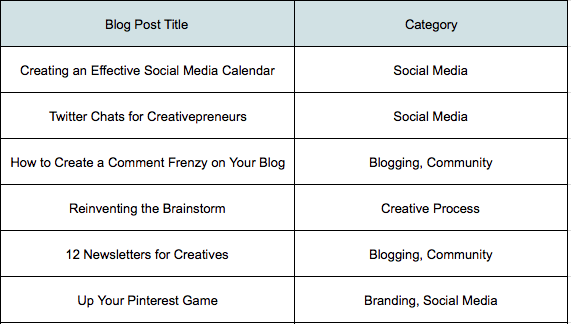Making the Most of Your Master List of Blog Post Ideas
August 10, 2015
The art of brainstorming is like a board game.
All the pieces need to be aligned in order to claim your victory. The reward: incredible, free-flowing ideas.
Before you embark on your brainstorming journey in search of new blog post ideas, let’s take an in-depth look at why it’s important to keep track of your ideas and how to do it in the most effective way possible. We are all in the business of trying to save time, right?
Why should you bother to keep an archive of blog post ideas?
- You’ll have ideas when your creative well runs dry (aka what most people call “writer’s block”).
- You’re able to build a more solid strategy in the long-term.
- You can create a timeline based on trendy and evergreen content.
- You won’t fall victim to procrastination.
I pull blog post ideas from my list monthly and set aside time at least once every month to list as many ideas as I can. This way, the ideas that are crossed off the list are quickly replaced with new ones.
Before you start brainstorming, keep my biggest rule of thumb in mind:
Every blog post idea that earns a spot on your master list should fit at least one of your categories.
I cannot stress this enough. My blog categories are blogging, branding, social media, community, creative process, and personal. If I have an idea that doesn’t quite fit these categories, I don’t write it down.
Why? Because that means the idea is off-brand, which is something I don’t want to pursue. Creating off-brand content could confuse your readers and maybe turn them off.
Of course, you can still write the idea elsewhere like a journal dedicated to side project ideas (everyone has one of these too, right?), but having a specific list only for your blog will help you stay on topic and consistently create relevant posts.
So what should your master list look like?
I’d like to replace the “should” in the above question with the word “can” because there’s no right or wrong format. I’ve tried many in my one and half years of blogging and have finally settled into one that feels like the right fit.
Originally I started with a list format where my ideas were separated only by bullet points. This running list worked alright in the beginning, but when I started to have several pages of ideas, it was hard to find past ideas and focus on similar themes. While this may work for some, I knew I needed to shift the format to better fit my needs.
Then I decided to separate my ideas into the categories I defined for my blog. Each category was a header and the corresponding ideas were listed below. This helped immensely with keeping everything organized.
I have continued to use this format, but I’ve updated it to include a simple tracker where I write each blog post title with its corresponding category. Here’s an example:
This helps me see if there’s an equal spread between all of my categories. By looking at this, I can quickly determine I need a Branding or Personal themed post for next week (since I’ve covering Creative Process today) to keep the flow of content. It can be super nifty and takes very minimal time to put together.




